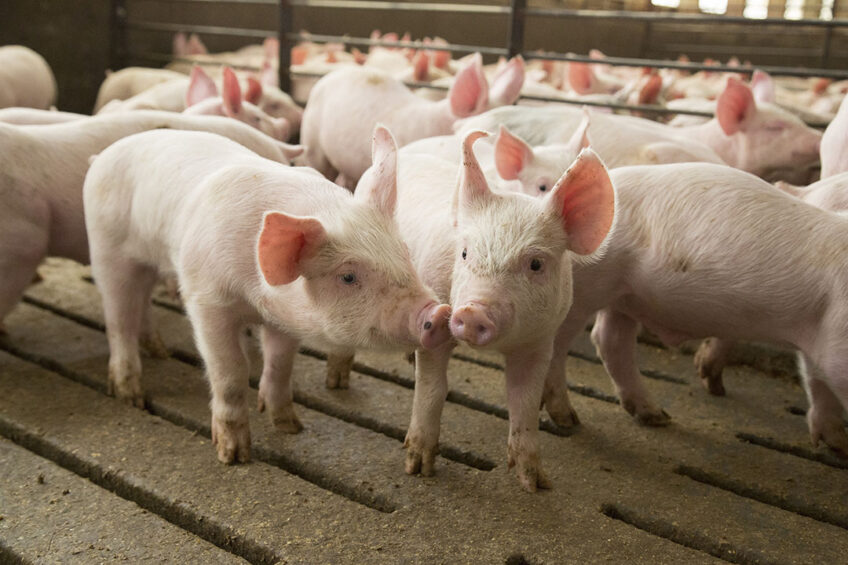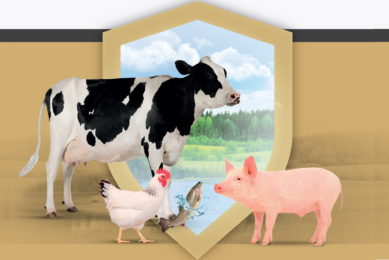Mycotoxins and pigs: Does low risk mean no risk?

Acute mycotoxicosis in pigs is a relatively rare phenomenon these days, as awareness and technology have increased in recent years. Yet mycotoxins may also be present in low dosages, which can lead to subclinical health problems.
Produced by moulds and frequently occurring in a wide variety of feedstuffs used in pig production, mycotoxins are a dynamic challenge requiring consideration and proactive management by pig producers across the globe.
Over the past 4 months of using the Alltech 37+ test for mycotoxins in corn, soybean, wheat and barley, 81% of all samples globally contained two or more mycotoxins, with an average of 4 mycotoxins per sample. When the company’s Risk Equivalent Quantity metric is applied to those results, it shows a higher risk to both nursery and breeding pigs and a moderate risk to grower-finisher pigs.
Low mycotoxin levels
Of all the animal species, pigs are among the most sensitive to the negative impact of unwanted toxins. Considering their high frequency of occurrence along with the concentrations in which they are found, it is extremely likely that mycotoxins are routinely consumed by animals. Thanks to continuous innovations in mycotoxin management and control, acute mycotoxicosis outbreaks are now considered rare events in modern animal production. However, even low mycotoxin levels – which often go undetected – can be responsible for reduced production efficiency and an increased susceptibility to infectious diseases. Additionally, these mycotoxins have been known to interact with other stressors, leading to subclinical losses in performance, increases in the incidence of disease and reduced reproductive performance. For animal producers, these subclinical losses are often of greater economic importance than losses from acute effects – but, again, these lower levels are even more difficult to diagnose.
What does “subclinical” mean?
This term describes an early stage or mild form of a medical condition, no symptoms of which are detectable. The adverse health effects associated with the contamination of feed materials by mycotoxins may lead to acute intoxications, which can be life-threatening. More common, however, are subacute and, often, subclinical alterations of organ function that impair weight gain and reduce productivity. Some of the most significant effects of low mycotoxin concentrations can be observed in the immune and antioxidant systems, where mycotoxin contamination often remains undetected.
The presence of moderate to low amounts of mycotoxins in daily feed rations increases the susceptibility of animals to viral, bacterial and parasitic diseases
Mycotoxin effects on the immune system
While impeded growth and reduced productivity are economically significant, the intrinsic activity of many mycotoxins in an animal’s immune system is of even more concern. The presence of moderate to low amounts of mycotoxins in daily feed rations increases the susceptibility of animals to viral, bacterial and parasitic diseases. That elevated susceptibility to disease necessitates an increase in therapeutic interventions with antibiotics and anti-parasitic drugs. That, in turn, increases the cost of animal health care and the use of anti-infective agents – particularly antibiotics – with a consequent increase in the risk of induction and the spread of antimicrobial resistance. The immunosuppressive effects of mycotoxins may also result in the incomplete protection of farm animals against viral diseases following vaccination, as their antibody formation is impaired.
Mycotoxin effects on antioxidant status
Increased cellular oxidative stress is a common result of exposure to many mycotoxins, due to the associated increase in the production of oxygen and hydrogen radicals and the depletion of cellular defence mechanisms, such as glutathione. Cellular oxidative stress and enhanced radical production lead to lipid peroxidation and cellular necrosis. Many mycotoxins also affect the transport of vitamins and provitamins, which encourages lipid peroxidation, impairs vital cellular function and induces programmed cell death (i.e. apoptosis), followed by cell necrosis.
The incorporation of mycotoxins into membrane structures causes various detrimental changes that are associated with the peroxidation of long-chain polyunsaturated fatty acids (PUFAs), or lipid peroxidation. That, in turn, alters membrane permeability, flexibility and other important characteristics that can affect membrane function.
Moreover, it is not currently clear if mycotoxins stimulate lipid peroxidation directly by enhancing the production of free radicals or if the increased tissue susceptibility to lipid peroxidation is the result of a compromised antioxidant system (see Figure 1).

Managing the mycotoxin challenge
Although lower level mycotoxin contamination may not always be of great concern to every pig producer, it is clear that, by not paying closer attention to it, the industry may be unnecessarily incurring what are often avoidable economic losses. Underestimating those long-term subclinical effects can notably hamper both the pig’s immunity and its antioxidant status, with subsequent negative impacts on areas like productivity, reproduction and disease status.
While there has been significant progress in the area of controlling mycotoxins, it is still generally impossible to eliminate them entirely from the animal feed supply chain. Fortunately for pig producers, there are steps that can be taken – from crop planting to the delivery of the feed to animals – that can help mitigate the mycotoxin challenge.
One of the key tools within this cycle is mycotoxin detection. Until the actual risk is identified and quantified, it can be very difficult to establish effective mycotoxin control programmes or make successful use of in-feed ingredients, such as mycotoxin binders, that are designed to remove mycotoxins from the pig’s digestive tract before they have a chance to cause serious harm.
Signs that pigs may be ingesting low levels of mycotoxins
• Compromised pig performance, increased feed conversion ratio and reduced feed intake;
• Reduced reproductive performance and increased amount of abortions;
• The immune system being the only thing apparently affected;
• Poor response to vaccination, low titres of antibodies;
• Live vaccines having harmful effects on the animal (vaccines do have the potential to become active and cause disease, especially in animals with weakened immune systems);
• Antibiotics used as therapeutics are not performing, even when used at higher dosages or for longer periods;
• An impaired transference of antibodies from breeding animals to their offspring;
• Respiratory diseases of unknown origin or that are difficult to diagnose.
References available upon request.











